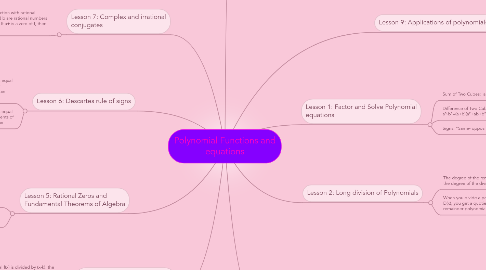Polynomial Functions and equations
par Kailey Flaherty


1. Lesson 4: Remainder and Factor Theorems
1.1. If a polynomial f(x) is divided by (x-k), the remainder is f(k)
1.2. Factor Theorem: k is a zero of a polynomial if (x-k) is a factor.
2. Lesson 5: Rational Zeros and Fundamental Theorems of Algebra
2.1. If f(x)=anxn+…+a1x+a0 has integer coefficients, then every rational zero of f has the following form: p/q factors of constant term /factors of the leading coefficients
2.2. If a zero appears more than once, it has a multiplicity
3. Lesson 6: Descartes rule of signs
3.1. The number of positive real zeros of f is equal to the number of changes in sign of the coefficients of f(x) or is less than this by an even number
3.2. The number of negative real zeros of f is equal to the number of changes of the coefficients of f(-x) or is less than this by an even number
4. Lesson 7: Complex and irrational conjugates
4.1. If f is a polynomial function with rational coefficients, and a and b are rational numbers such that is irrational. If a+ is a zero of f, then a- is also a zero of f
5. Lesson 1: Factor and Solve Polynomial equations
5.1. Sum of Two Cubes: a³+b³=(a+b)(a²-ab+b²)
5.1.1. Difference of Two Cubes: a³-b³=(a+b)(a²+ab+b²)
5.1.2. Difference of Two Cubes: a³-b³=(a+b)(a²+ab+b²)
5.1.3. Difference of Two Cubes: a³-b³=(a+b)(a²+ab+b²)
